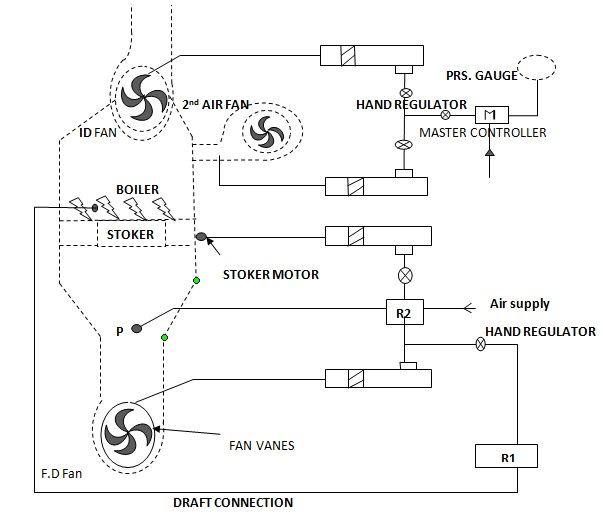This set of Energy Engineering Multiple Choice Questions & Answers (MCQs) focuses on “Principle of Automatic Control of Combustion”.
1. What is the basis on principle of automatic control of combustion is determined?

a) Control of fuel supply to the boiler
b) Speed of rotation of fans
c) Control of combustion
d) Control of steam pressure
View Answer
Explanation: The principle of automatic control of combustion is derived from the control of combustion. In order to ensure sufficient amount of steam generation at the requisite pressure and to maintain correct proportion of fuel and air in a furnace for complete combustion, control of combustion in the furnace is very much essential.
2. What quantities need to maintained/regulated for effective control of combustion?

a) Induced draught and forced draught fans pressure
b) Air and steam gauge pressure
c) Fuel flowing out of stoker
d) Air and fuel supply
View Answer
Explanation: Combustion can be effectively controlled by regulating the quantities of air and fuel or both. Control of combustion can be by manual or automatic means. Automatic control of combustion is used to distribute the load evenly on the boiler as per the changing demand.
3. What is necessary to ensure products of combustion flow into the chimney?

a) Air speed
b) Draft in the chimney
c) Differential gas pressure
d) Swirl flow of exhaust air
View Answer
Explanation: In order to ensure products of combustion flow into the chimney at proper speed, it is essential to regulate differential gas pressure in the furnace. In case of automatic control, the controlling devices operate based on the change in pressure of steam.
4. When does automatic control system of combustion come into operation?

a) When there is no fluctuation in furnace draft
b) When there is variation in steam flow rate
c) When the draft connection is clogged
d) When there is minimal amount of air supply
View Answer
Explanation: Automatic control combustion system comes into action when there is variation in steam flow rate also when there is fluctuation in steam pressure and furnace draft. It is safer compared to manual control system and saves manual labour and time.
5. Which is the component that maintains forces in whole automatic combustion control system?

a) Steam pressure gauge
b) Fan vanes
c) Master controller
d) Relay 1 & 2
View Answer
Explanation: Master controller is the component that maintains all the forces in whole system. The actions of primary forces are magnified through the master controller which in turn operates the concerned elements through electric, hydraulic and pneumatic system. The master control makes variation depending on steam pressure level.
6. When does master controller comes into action?

a) When there is variation in steam flow rate
b) When there is variation in fuel supply
c) When there is variation in steam pressure
d) When there is variation in draught fans
View Answer
Explanation: The master controller comes into action when there is variation in steam pressure and it goes down below the required level. This activates the servo motor coupled to the vanes of induced draught fan which opens the air damper slightly. Simultaneously the secondary fan air damper also opens proportionately.
7. When does relay’s 1 and 2 come into operation?

a) When there are changes in steam pressure
b) When there is change in forced draught
c) When there is change in steam flow rate
d) When there is change in induced draught
View Answer
Explanation: When there are variation made in induced draught by air dampers opening due to coupling of motor that’s when relay 1 and 2 comes into operation. Relay 1 operates and adjusts the forced draught fan vanes till stability is restored in the combustion chamber. This result in an increased flow rate of air through the passage P. Due to increased flow rate, relay 2 is actuated which speeds up the stoker motor to supply extra fuel.
8. What is the purpose of Automatic combustion control system?

a) To get constant steam pressure
b) To maintain steady state combustion
c) To get constant steam output
d) To save the time and manual labour
View Answer
Explanation: The automatic combustion control system provides the effective prevention of the environmental pollution and steady combustion condition to get a constant steam output. But few factors prevent steady combustion condition such as unbalanced combustion air and the movement of the burn-out position in the incinerator.
Sanfoundry Global Education & Learning Series – Energy Engineering.
To practice all areas of Energy Engineering, here is complete set of 1000+ Multiple Choice Questions and Answers.
If you find a mistake in question / option / answer, kindly take a screenshot and email to [email protected]
- Check Mechanical Engineering Books
- Check Energy Engineering Books
- Apply for Environmental Engineering Internship
- Practice Environmental Engineering MCQs
- Check Environmental Engineering Books
